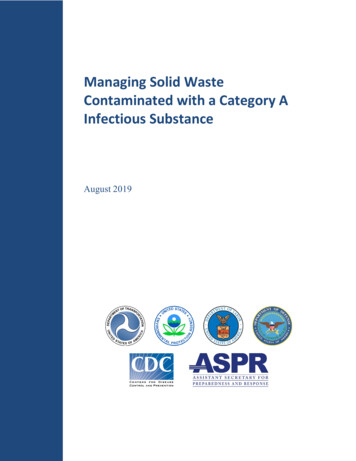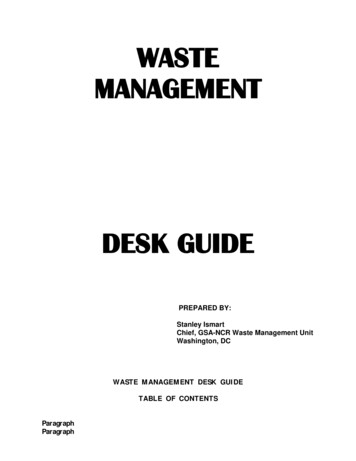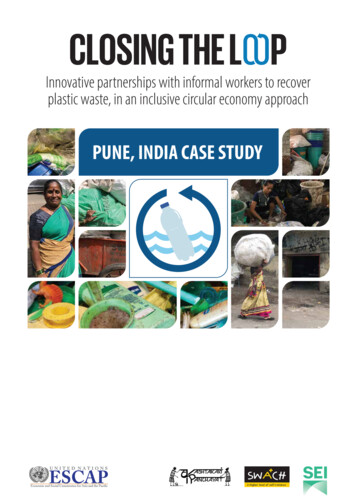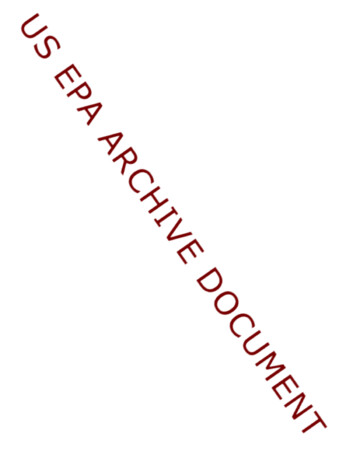
Transcription
Managing Solid WasteContaminated with a Category AInfectious SubstanceAugust 2019
Managing Solid Waste Contaminated with a Category A Infectious SubstanceThis document was approved for publication by the National Security Council (NSC)-led DomesticResilience Group (DRG) on August 19, 2019.This documents supersedes an interim version, previously published on January 19, 2017.This document does not create new requirements, nor does it remove the obligation to comply with allapplicable federal, state, local, tribal, and territorial laws and regulations.i
Managing Solid Waste Contaminated with a Category A Infectious SubstanceCONTENTSPreface . iiiAcronyms & Glossary of Terms . vAcronyms . vGlossary of Terms . viiiPlanning Guidance for Handling Solid Waste Contaminated with a Category A Infectious Substance . 1Key Points . 11. Introduction . 32. Category A Waste: What It Is and What It Is Not . 43. Overarching Planning Considerations . 54. Federal Government Roles & Responsibilities . 95. Waste Generator Information & Responsibilities . 116. Waste Transporter Information & Responsibilities . 167. Waste Treatment Information & Responsibilities. 188. Final Disposal Information & Responsibilities . 239. Protecting Worker Health and Safety . 26Appendix A – Additional Resources . 33Appendix B – Infectious Agent Categorization . 37Appendix C – Decision Matrix for Waste Treatment . 43Appendix D – Questions and Answers . 47Background Questions & Answers . 49Waste Generation Questions & Answers . 61Waste Transportation Questions & Answers . 63Waste Treatment Questions & Answers . 70Waste Disposal Questions & Answers. 74Worker Protection Questions & Answers . 79Appendix E – Directory of State and Territorial Waste Management Programs. 87Appendix F – Pathogen-Specific Information . 91F-1. Ebola. 91ii
Managing Solid Waste Contaminated with a Category A Infectious SubstancePREFACESolid waste contaminated with infectious substances can be managed safely. 1In the United States, much of this waste comes from hospitals, other healthcare facilities, medicaltransportation operations, and laboratories, though people with certain infectious diseases may alsogenerate such waste at home. Infectious waste is routinely treated, transported, and disposed of in waysthat protect the health of the American public, the environment, and workers.However, the 2014–2015 experiences with individuals with Ebola virus disease (EVD) in the UnitedStates tested the nation’s capacity for managing solid waste contaminated with Ebola virus or otherpotentially highly infectious waste—classified as Category A infectious substances under the U.S.Department of Transportation’s Hazardous Materials Regulations (HMR). The HMR classify aninfectious substance (and solid waste containing it) as “Category A” if it is in a form (e.g., untreated)capable of causing permanent disability or life-threatening or fatal disease in otherwise healthy humans oranimals upon exposure to the substance. 2 The HMR require certain safety measures, including specialpermits and packaging, for commercial transportation of materials contaminated with Category Ainfectious substances (referred to as “Category A waste” throughout this document). Challengesassociated with managing Category A waste generated by U.S. patients with EVD—both before andduring hospitalization—highlighted a lack of universal understanding about how to handle such waste, aswell as poor acceptance of the fact that these activities can be done safely.A product of extensive federal interagency coordination and stakeholder input, this guidance aims toprepare the nation to effectively manage Category A waste associated with infectious disease incidents.The guidance also aims to improve understanding of the safety of infectious waste managementprocesses. It is intended to help government and non-governmental leaders, local emergency medicalservices, emergency managers, hospitals, healthcare providers, laboratories, environmental servicesworkers, waste management companies and workers, and related stakeholders safely handle, inactivate,transport, and dispose of Category A waste. 3 The guidance provides key information about proceduresand regulations regarding Category A waste. In addition to the HMR, the document discusses additionalU.S. Department of Labor (DOL)/Occupational Safety and Health Administration (OSHA), U.S.Department of Health and Human Services (HHS)/Centers for Disease Control and Prevention (CDC),and U.S. Department of Agriculture (USDA) requirements, including federal select agent regulations ofHHS/CDC at 42 CFR part 73 and USDA at 7 CFR part 331 and 9 CFR part 121, that may be relevant forwaste management planning. The guidance is supplemented by several appendices that provide additionalresources, assist with decision making, and address questions and answers about Category A waste.1The definition of solid waste is not limited to wastes that are physically solid. Many solid wastes are liquid, semisolid, or contained gaseous material. For more information, see definition of “solid waste” in Glossary of Terms.2Hazardous Materials Regulations, 49 CFR § 173.134(a)(1)(i) (2013).Parts of this guidance may not apply to every hospital, healthcare facility, or laboratory in every state. Contactstate, local, tribal, and/or territorial officials to discuss your organization’s waste management plans in order toprepare for an incident before one occurs. See the directory of state and territorial waste management programs inAppendix E – Directory of State and Territorial Waste Management Programs.3iii
Managing Solid Waste Contaminated with a Category A Infectious SubstanceThis guidance focuses on managing waste contaminated with the Category A infectious substances thataffect humans. 4 These substances are identified by the United Nations (UN) identification number 2814under an international system for identifying hazardous materials. Appendix B – Infectious AgentCategorization provides a non-exhaustive list identifying, among other categorizations, common agentsclassified as UN 2814 Category A infectious substances affecting humans. Medical care of a personsuspected of or confirmed as having a disease caused by a Category A pathogen (i.e., germ) typicallygenerates used healthcare products or linens that are classified as Category A waste. While this documentchiefly addresses Category A waste associated with hospital care of infectious patients, it also recognizesthat infected people may contaminate their homes, vehicles in which they travel, and other environmentsbefore they are hospitalized. Category A waste may also come from laboratories that work with UN 2814Category A pathogens, including when they intentionally cultivate certain pathogens (a process known as“culturing”) that are not considered Category A (i.e., UN 2814 infectious substances) in other forms (e.g.,in body fluids or tissues of an infected person). 5 Where appropriate, this document addresses theseadditional, non-healthcare scenarios and settings from which Category A waste may arise.Information in this guidance serves several purposes. As a whole, the document offers readers anoverview of Category A waste management in the United States. The main component of this guidanceaddresses planning for Category A waste management activities, including considerations for developing,evaluating, and revising organizational (e.g., hospital) or jurisdictional (e.g., state, territorial, or local)plans. It is presented in sections that break down waste management activities according toresponsibilities as waste is moved from its point of generation to its place of disposal. Severalaccompanying appendices provide users with information about pathogens classified as Category Ainfectious substances, decision making for waste treatment and disposal activities, communicatingeffectively about safe waste management and associated issues, and additional related resources. Theincluded listing of acronyms and glossary of terms applies to the entire document. Unless otherwisenoted, references to a particular appendix or section refer to parts of this document (and, in the electronicversion, can be clicked to navigate to that information directly).Note that this document intentionally repeats some information, particularly when waste managementrequires actions from multiple parties (e.g., overlapping responsibilities between waste generators andwaste transporters). Information presented in the planning guidance is also intentionally repeated in theappendices to make it as accessible as possible for a wide variety of readers.This document is not intended to cover Category B infectious substances (UN 3373) nor Category A Infectioussubstances that affect animals only (UN 2900). Category A infectious substances that affect humans and animals arecategorized as Category A Infectious substances, affecting humans (UN 2814).4Appendix B – Infectious Agent Categorization distinguishes these “cultures only” pathogens from other CategoryA pathogens.5iv
Managing Solid Waste Contaminated with a Category A Infectious SubstanceACRONYMS & GLOSSARY OF TERMSACRONYMSAPHISAnimal and Plant Health Inspection ServiceASPRAssistant Secretary for Preparedness and ResponseBSATBiological Select Agents and ToxinsCAAClean Air ActCDCCenters for Disease Control and Preventionc/oCultures onlyCFRCode of Federal RegulationsDHSU.S. Department of Homeland SecurityDoDU.S. Department of DefenseDOEU.S. Department of EnergyDOLU.S. Department of LaborDOTU.S. Department of TransportationDRGDomestic Resilience GroupDTRDefense Transportation RegulationEMSEmergency Medical ServicesEMTALAEmergency Medical Treatment and Labor ActEPAU.S. Environmental Protection AgencyEPCRAEmergency Planning and Community Right-to-Know ActEVDEbola virus diseaseFBIFederal Bureau of InvestigationFDAFood and Drug AdministrationFIFRAFederal Insecticide, Fungicide, and Rodenticide ActHAZMATHazardous materialsv
Managing Solid Waste Contaminated with a Category A Infectious SubstanceHAZWOPER Hazardous Waste Operations and Emergency ResponseHBVHepatitis B virusHFVHemorrhagic fever virusHHSU.S. Department of Health and Human ServicesHICPACHealthcare Infection Control Practices Advisory CommitteeHIVHuman immunodeficiency virusHMIWIHospital/medical/infectious waste incineratorHMRHazardous Materials RegulationsHWHazardous wasteHWIHazardous waste incineratorICAOInternational Civil Aviation OrganizationIMDGInternational Maritime Organization Dangerous Goods CodeIVIntravenousLDRLand Disposal RestrictionLEPCLocal emergency planning committeeMMRMeasles, mumps, and rubellaN/ANot applicableNETECNational Ebola Training and Education CenterNESHAPNational Emission Standards for Hazardous Air PollutantsNIEHSNational Institute of Environmental Health SciencesNIOSHNational Institute for Occupational Safety and HealthNSCNational Security CouncilNSPSNew Source Performance StandardsOPIMOther potentially infectious materialsOSHOccupational Safety and HealthOSHAOccupational Safety and Health Administrationvi
Managing Solid Waste Contaminated with a Category A Infectious SubstancePHMSAPipeline and Hazardous Materials Safety AdministrationPPEPersonal protective equipmentPUIPatient (or person) under investigation (i.e., for a disease)RCRAResource Conservation and Recovery ActRESPTCRegional Ebola and Other Special Pathogens Treatment CenterRMWRegulated medical wasteSARS-CoVSevere Acute Respiratory Syndrome-associated coronavirusSLTTState, local, tribal, and/or territorialSPSpecial permitTBMycobacterium tuberculosisTdapTetanus, diphtheria, and pertussisTRACIETechnical Resources, Assistance Center, and Information ExchangeUNUnited NationsUSCUnited States CodeUSDAU.S. Department of AgricultureWHOWorld Health Organizationvii
Managing Solid Waste Contaminated with a Category A Infectious SubstanceGLOSSARY OF TERMSAirborne transmission: One of the three main conventional routes of infectious disease transmission,which involves either airborne droplet nuclei (i.e., the infectious material left behind when liquid dropletscontaining infectious materials evaporate) or small particles in the respirable size range containinginfectious agents. Once released from an infectious source, these small particles can stay suspended in theair for various amounts of time, depending on their size and various environmental factors, and travel arange of distances to a susceptible host (i.e., a person who does not have immunity to that specificpathogen. Larger particles settle (i.e., deposit) on environmental surfaces and other fomites. Somepathogens (i.e., germs) can remain viable in the air or on environmental surfaces and fomites for longperiods of time. Infection can occur when the infectious particles enter the host, such as when they arebreathed in from the air.Autoclave: A sterilization machine that utilizes a standardized process involving saturated steam underpressure for a specified exposure time and at a specific temperature.Bioaerosol: A suspension of airborne particles, generally comprised of microorganisms (e.g., bacteria,viruses) or materials of biological origin released from humans, animals, plants, soil, water, or othersources. Particles may range in size from very small to very large, and may include liquid droplets andmaterials left behind after such droplets evaporate (known as “droplet nuclei”).Biological Select Agents and Toxins (BSAT): See “Select agent.”Bloodborne pathogens (BBP): Pathogenic microorganisms that are present in human blood (includinghuman blood components and products made from human blood) that can cause disease in humans.Bloodborne Pathogens (BBP) standard: The Occupational Safety and Health Administration (OSHA)standard that requires employers to protect workers from occupational exposure to bloodborne pathogens(as defined above and including some Category A infectious substances). The standard applies toexposure to blood and other potentially infectious materials, including semen, vaginal secretions,cerebrospinal fluid, synovial fluid, pleural fluid, pericardial fluid, peritoneal fluid, amniotic fluid, saliva indental procedures, any body fluid that is visibly contaminated with blood, all body fluids in situationswhere it is difficult or impossible to differentiate between body fluids, any unfixed tissue or organ (otherthan intact skin) from a human (living or dead), and HIV-containing cell or tissue cultures, organ cultures,and HIV- or Hepatitis B virus (HBV)-containing culture medium or other solutions; and blood, organs, orother tissues from experimental animals infected with HIV or HBV. See 29 CFR § 1019.1030.Category A infectious substance: An infectious substance in a form capable of causing permanentdisability or life-threatening or fatal disease in otherwise healthy humans or animals when exposure to thesubstance occurs. See 49 CFR § 173.134(a)(1)(i). Note that Category A infectious substances described inthis document and covered by the Hazardous Materials Regulations (HMR) at 49 CFR parts 171-180should not be confused with the select agents regulated by the Federal Select Agent Program under 7 CFRpart 331, 9 CFR part 121, and 42 CFR part 73 (although an infectious substance or agent may be bothcovered by the HMR and listed as a select agent); shipments of select agents must be transported inaccordance with federal select agent regulations. Infectious substances labeled “cultures only” inAppendix B – Infectious Agent Categorization are only considered Category A when a pathogen(s) isintentionally propagated, such as when a laboratory grows more of the pathogen for clinical diagnostic orbiomedical research purposes. The other substances, such as Ebola virus (and other hemorrhagic feverviruses, HFVs) and variola virus (which causes smallpox), are considered Category A without beingcultured.viii
Managing Solid Waste Contaminated with a Category A Infectious SubstanceCategory A waste: Waste contaminated with a Category A infectious substance. This waste must bepackaged and transported in accordance with the Hazardous Materials Regulations (HMR) or anapplicable DOT special permit.Category B infectious substance: An infectious substance that is not in a form generally capable ofcausing permanent disability or life-threatening or fatal disease in otherwise healthy humans or animalswhen exposure to it occurs. Transport as Biological substance, Category B (United Nations (UN) 3373).See 49 CFR § 173.134(a)(1)(ii).Chemoprophylaxis: Administration of medication before, during, or after possible or known exposure toa pathogen to prevent either infection or disease.Clean Air Act (CAA): The comprehensive federal law under the authority of which the U.S.Environmental Protection Agency (EPA) regulates air emissions from stationary and mobile sources.Among other things, this law authorizes EPA to establish National Ambient Air Quality Standards toprotect public health and public welfare and to regulate emissions of hazardous air pollutants.Commerce: Trade or transportation in the jurisdiction of the United States within a single state, betweena place in a state and a place outside of the state, that affects trade or transportation between a place in astate and place outside of the state, or on a United States-registered aircraft. See 49 CFR § 171.8.Contact transmission: One of the three main conventional routes of infectious disease transmission,which involves transfer of microorganisms from a source, such as an infected person, to a susceptiblehost, such as another person. Indirect contact transmission is when such transfer occurs through acontaminated intermediate object or person (i.e., a fomite). Direct contact transmission occurs whenmicroorganisms are transferred without a contaminated intermediate object or person.Contaminated waste: See “Category A waste,” as these terms are used synonymously in the document.Disinfectant: An antimicrobial product, typically in the form of a liquid or liquid-containing wipe thatwill make certain biological agents, such as bacteria or viruses, inactive. Such products should be an U.SEnvironmental Protection Agency (EPA)-registered disinfectant or one with microbial pathogen claimsappropriate for the pathogen. 6 Although not covered in this document, this term can also apply to Foodand Drug Administration (FDA)-regulated liquid products used specifically on critical devices.Droplet transmission: The transfer of infectious agents by droplets traveling directly from a source, suchas an infected person’s respiratory tract, to susceptible mucous membranes of a recipient.Endemic: The condition in which a particular disease is naturally present in a particular community,population, or geographic area.Such products are included in EPA’s List L: EPA's Registered Antimicrobial Products that Meet the CDC Criteriafor Use Against the Ebola Virus (see U.S. Environmental Protection Agency, “List L: EPA's RegisteredAntimicrobial Products that Meet the CDC Criteria for Use Against the Ebola Virus,” last modified January 20,2017, www.epa.gov/oppad001/list-l-ebola-virus.html); U.S. Department of Health and Human Services, Centers forDisease Control and Prevention, “Interim Guidance for U.S. Residence Decontamination for Ebola and Removal ofContaminated Waste,” last modified August 5, 2015, .html.6ix
Managing Solid Waste Contaminated with a Category A Infectious SubstanceFomite: An object, item, or material (e.g., equipment, furniture, bedding, clothing) that can carry andspread pathogens.Frontline healthcare facility: A healthcare facility that is prepared to rapidly identify and isolate patientswho may have Ebola or other highly infectious diseases. Such a facility must be able to promptly inform:the hospital/facility infection control program; state and local public health agency; and an assessmenthospital (which can receive and isolate patients under investigation for highly infectious diseases and carefor such patients until a diagnosis can be made and until discharge or transfer is completed), or RegionalEbola and Other Special Pathogens Treatment Center (RESPETC) or state/jurisdiction treatment center(which can safely care for patients with highly infectious diseases in the event that a cluster of suchpatients overwhelms the RESPTC), as necessary, to arrange patient transfer. Frontline healthcare facilitiesare also responsible to provide stabilizing treatment, per the Emergency Medical Treatment and LaborAct (EMTALA) requirements. Frontline healthcare facilities are part of a tiered approached for managingsuspected and confirmed cases of highly infectious diseases in the United States.Generator: The person or persons whose act or process produces (i.e., generates) waste. This termgenerally provides a way to describe waste generators irrespective of what type of waste they produce(e.g., solid, liquid, semi-liquid, infectious, hazardous, etc.). However, this term has a specific meaningunder the hazardous waste regulations of the Resource Conservation and Recovery Act (RCRA) subtitleC, and hazardous waste generators must adhere to specific requirements for both managing theirhazardous waste on-site and ensuring proper management off-site. See www.epa.gov/hwgenerators.Despite sick patients’ physiological processes generating waste (e.g., vomitus, feces), the term“generator” typically does not apply to such patients; instead, it applies to healthcare or medical transportorganizations caring for and moving them, laboratories testing clinical samples obtained from them,environmental remediation companies cleaning their homes, or others whose activities result in creatingthe waste. See also “Offeror.”Hazardous material: A substance or material that the Secretary of Transportation has determined iscapable of posing an unreasonable risk to health, safety, and property when transported in commerce, andhas designated as hazardous under section 5103 of federal hazardous materials transportation law (49USC section 5103). The term includes hazardous substances, hazardous wastes, marine pollutants,elevated temperature materials (as defined at 49 CFR § 171.8), materials designated as hazardous in theHazardous Materials Table (see 49 CFR § 172.101), and materials that meet the defining criteria forhazard classes and divisions in part 173 of the Hazardous Materials Regulations (HMR). See 49 CFR §171.8.Hazardous Materials Regulations (HMR): The U.S. Department of Transportation (DOT) regulationsat 49 CFR parts 171-180.Hazardous waste: A specific term defined in the Resource Conservation and Recovery Act (RCRA) andimplementing regulations. “Hazardous waste” is a subset of “solid waste” (where solid waste can be aliquid, semi-solid, solid, or contained gaseous material) that when improperly managed poses a seriousthreat to human health and the environment. There are specific regulatory definitions of “hazardouswaste” with which waste generators should be familiar. For purposes of transportation, “hazardous waste”refers to any material that that is subject to the Hazardous Waste Manifest Requirements of the U.S.Environmental Protection Agency (EPA), specified in 40 CFR part 262.Hazardous Waste and Emergency Response Operations (HAZWOPER) standard: The OccupationalSafety and Health Administration (OSHA) standard that requires employers to protect workers engaged incertain types of emergency response and recovery operations, including emergency response operationsx
Managing Solid Waste Contaminated with a Category A Infectious Substancefor releases of, or substantial threats of releases of, hazardous substances regardless of the location of thehazard. See 29 CFR § 1910.120.HAZMAT employee: A person who, in the course of their employment directly affects hazardousmaterials transportation safety. This term includes a person, who during the course of employment: (1)loads, unloads, or handles hazardous materials; (2) designs, manufactures, fabricates, inspects, marks,maintains, reconditions, repairs, or tests a package, container, or packaging component that is represented,marked, certified, or sold as qualified for use in transporting hazardous material in commerce; (3)prepares hazardous materials for transportation; (4) is responsible for safety of transporting hazardousmaterials; or (5) operates a vehicle used to transport hazardous materials. See 49 CFR § 171.8.In commerce: Trade or transportation in the jurisdiction of the United States within a single state,between a place in a state and a place outside of the state, that affects trade or transportation between aplace in a state and place outside of the state, or on a United States-registered aircraft. See 49 CFR §171.8. Transportation of a hazardous material in a motor vehicle, aircraft, or vessel operated by a federalor state, local, tribal, or territorial government employee solely for noncommercial federal or state, local,tribal, and/or territorial (SLTT) government purposes is not considered to be “in commerce” and so isexempt from the Hazardous Materials Regulations (HMR) under 49 CFR § 171.1(d)(5).Inactivated: Having reached the point, through incineration, autoclaving, or other validated treatment,where the waste material is no longer infectious, does not pose an infection risk, and is not considered tobe a regulated medical waste or a hazardous material when transported in commerce.Incineration: The combustion of waste primarily for destruction. This process can reduce large volumesof waste materials to ash and lessen toxic gaseous emissions. Residues or residuals (e.g., ash) from thecombustion of hazardous waste are also potentially subject to Resource Conservation and Recovery Act(RCRA) regulations for disposal.Incinerator, hazardous waste (HWI): A type of combustor that is designed, operated, and permitted toburn hazardous waste. HWIs are subject to applicable federal and/or state, local, tribal, and/or territorial(SLTT) regulatory requirements pursuant to both the Resource Conservation and Recovery Actrequirements (40 CFR parts 264, 265, and 266) and Clean Air Act standards (40 CFR part 63). Waste feedcapacity (i.e., waste size and volume/weight throughput limits over a specified period of time, such as anhour) for HWIs is an important criterion to know before a biological incident occurs, as each HWI may beset up to accept different waste amounts and sizes.Incinerator, medical waste: A type of incinerator that is designed, operated, and permitted to burnwastes produced by hospitals, veterinary facilities, and medical research facilities for the purpose ofinactivating pathogens. These wastes include both infectious (i.e., red/biohazard bag) medical waste andnon-infectious, general housekeeping waste. Hospital/medical/infectious waste incinerators are subject toapplicable Clean Air Act requirements (40 CFR part 60). Waste feed capacity (i.e., waste size andvolume/weight throughput limits over a specified period of time, such as an hour) for medical wasteincinerators is an important criterion to know before a biological incident occurs, as each medical wasteincinerator may be set up to accept different waste amounts and sizes.Infectious
In the United States, much of this waste comes from hospitals, other healthcare facilities, medical transportation operations, and laboratories, though people with certain infectious diseases may also generate such waste at home. Infectious waste is routinely treated, transported, and disposed of in ways











